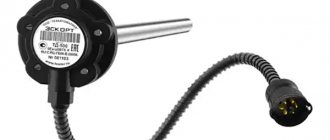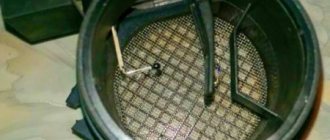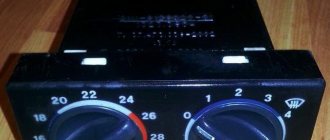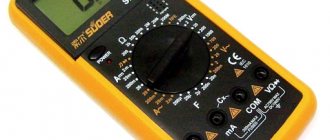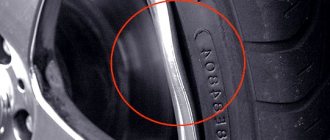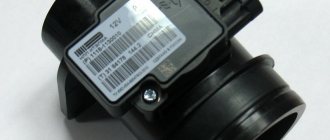What is the mass air flow sensor, a valuable structural part of the car. This indicator is necessary for the electronic device that controls the motor. To monitor the correct amount of air being supplied. In this case, it is the air that is combustible for the fuel mixture. The sensors come in different designs, but their failure will lead to a malfunction of the main operating process of the car.
DMRV what is it
In modern cars, engines are equipped with gasoline injection devices. Therefore, it is necessary to use special measuring sensors - mass air flow sensors. Modern air flow indicators are installed on diesel and gasoline engines.
Functions and purpose of the sensor
Nowadays, cars use two types of fuel supply: with distributed injection, fuel is supplied to the inlet pipe, and with direct injection, fuel is supplied directly into the chamber. In both situations, the operation of the vehicle depends on the correct functionality of the mass air flow sensor. Several years ago it worked on a mechanical basis, but now there are no moving elements and the sensor is manufactured on a hot-wire type.
The mass air flow sensor is suitable for any type of engine, and the functionality of the valve of the exhaust gas removal and neutralization complex is concentrated on it.
As experienced drivers like to say, the engine does not function in only two ways - there is nothing to burn or nothing to ignite.
Using an air flow sensor, the control unit receives information about the volume of gases entering through the intake channel, which regulates the required amount of fuel to produce the mixture.
Determining the condition of the filament and film mass air flow sensor
As already mentioned, filament sensors are simple and trouble-free, as well as self-cleaning. To determine the condition of the mass air flow sensor, voltage measurements should be taken. To do this, you will need a multimeter: for such devices the normal value is 1V, the maximum permissible voltage is 1.3V. With film mass air flow sensors it is a little more complicated: with the same nominal value, the permissible spread is only 0.02V.
The film sensor has a voltage range that allows you not only to determine whether the sensor is working or not, but also to learn about its “intermediate” state. For example, with readings in the range of 1.040-1.049V, it is highly recommended that the car owner replace the mass air flow sensor, as it is on the verge of failure. And if the multimeter produces 1.020-1.029V, then this means that the sensor has half its service life remaining.
The second method requires measuring the maximum voltage. True, it is not applicable to turbocharged engines, but on engines with a cable throttle you only need to open it sharply. If the peak voltage does not rise to 4V, this is considered a symptom of a sensor failure. However, if we are talking about cars with an electronic throttle, then the number of Volts may not reach this mark.
DMRV - what is it
The air flow indicator is designed to inform the owner that air is moving into the engine, because oxygen is a combustion catalyst for a flammable composition. Having received data from the air flow sensor, the fuel system prepares a correctly formed combustible mixture and ensures complete combustion of the fuel. The device located in the fuel inlet path includes two resistors. Which are performed in all sorts of variations.
In one embodiment, the element is exposed to a passing air mass. With a change in its intensity, the temperature of the thread decreases, as does the immanent resistance. In another embodiment, the resistor is not affected by the air mass. Based on the difference in resistance of the two elements, the volume of oxygen required by the motor for operation is calculated.
A few words about washing the sensor
Many car owners and even experienced auto mechanics are absolutely sure: the factory characteristics of the mass air flow sensor can be “revived” by simply washing the sensor. They say that it is enough to carefully remove it from the housing and treat it with a cleaning agent in the form of liquid for flushing the fuel system, alcohol and even acetone. After all, this is how carburetor jets were washed with great success several decades ago. In fact, experimenting with universal solvents is more expensive. Perhaps such “rejuvenating” liquids will help in the fight against pollution, however, as practice shows, the probability of success is 50/50. Or there may be a completely different combinatorics, when the DMVR dies without a single percentage for restoration...
Of course, it is impossible to prevent “spilling” the sensor. Moreover, in the diverse line of highly specialized auto chemical products there actually are compositions intended specifically for these purposes. And yet, compared to even the overly promoted WD-40, they will cost an order of magnitude higher. In addition, the manufacturers of such cleaners clearly indicate that a half-tired sensor cannot be brought to full condition, that is, it still will not work like a completely new one. The only thing such liquids are good for is carrying out preventive flushing of serviceable flow meters by removing contaminants arising from dust and oil “mist” that can get from the crankcase ventilation system into the intake manifold.
The principle of operation of the mass air flow sensor
At its core, mass air flow sensors are equipped with two sensitive thermistors in the form of a very thin heating metal wire. A direct current is supplied to them to heat them to the required number of degrees. One wire is in the air mass, due to the influence of air it is cooled. The second is provided with protection in the form of a screen. Thanks to this, the air cools the second thread less. Based on the difference between these two resistors, the air volume required for the smooth functioning of the engine is determined.
air supply sensor
Some MAF indicators have a built-in thermometer that shows the temperature order of the incoming air mass. This allows for more accurate calculations. Also, instead of metal threads, ceramic heating elements and thin films can be used. One way or another, they work according to the same system - the temperature difference between two components is taken into account - open and protected.
How to check the air flow meter
The process of checking the air flow meter is simple and can be done in several ways. Let's look at them in more detail.
Disabling the sensor
The simplest method is to turn off the flow meter. To do this, it is necessary to disconnect the power wire suitable for the sensor (usually red and black) with the engine turned off. After this, start the engine and drive the car. If the Check Engine warning light lights up on the dashboard, the idle speed exceeds 1500 rpm, and the car's dynamics have improved, then it is highly likely that your mass air flow sensor is faulty. However, we recommend that you perform additional diagnostics.
Checking with a scanner
Another diagnostic method is using a special scanner to identify errors in car systems. Currently, there is a wide variety of such devices. More professional models are used at service stations or service centers. However, for the average car owner there is a simpler solution.
It consists of installing special software on a smartphone or tablet with the Android operating system. Using a cable and adapter, the gadget is connected to the car's ECU, and the mentioned program allows you to obtain information about the error code. To decipher them you need to use reference literature.
Popular adapters:
Adapter ELM327
- K-Line 409.1;
- ELM327;
- OP-COM.
As for software, most often car owners use the following software:
- Torque Pro;
- OBD Auto Doctor;
- ScanMaster Lite;
- BMWhat.
The most common error codes:
- P0100 - mass or volumetric air flow sensor circuit;
- P0102 - low signal level at the input of the mass or volumetric air flow sensor circuit;
- P0103 - high signal level at the input of the mass or volumetric air flow sensor circuit.
Using the listed hardware and software, you can not only search for air flow meter errors, but also make additional settings for the installed sensor or other components of the car.
Checking the flow meter using a multimeter
Checking the mass air flow sensor with a multimeter
Also popular among car enthusiasts is the method of checking the flow meter using a multimeter. Since the most popular mass air flow sensor in our country is BOSCH, the verification algorithm will be described specifically for it:
- Turn on the multimeter in DC voltage measurement mode (abbreviated as DC). Set the upper limit so that the device can detect voltages up to 2 V.
- Start the car engine and open the hood.
- Find the air flow meter directly. It is usually located on or behind the air filter housing.
- The red lead of the multimeter must be connected to the yellow wire on the sensor, and the black lead to the green one.
- If the sensor is working properly, then the voltage value on the multimeter screen should not exceed 1.05 V. If the voltage is significantly higher, it means that the sensor has completely or partially failed.
We provide you with a table that shows the value of the received voltage and the state of the sensor.
| Voltage value, V | Sensor status |
| 0,966…1,01 | Voltage value on the new mass air flow sensor |
| 1,01…1,02 | Good condition of the sensor |
| 1,02…1,03 | Average condition |
| 1,03…1,04 | Sensor life is coming to an end |
| 1,04…1,05 | Very bad condition |
| Over 1.05 | The sensor needs to be replaced urgently |
Visual inspection and cleaning of the air flow meter
If you do not have a scanner or appropriate software at hand to diagnose the condition of the mass air flow sensor, you should perform a visual inspection of it in order to identify a malfunction of the air flow meter. The fact is that there are often situations when dirt, oil or other process fluids get into its body. This results in errors in the data produced by the device.
For a visual inspection, the first step is to dismantle the flow meter. Each car model may have its own nuances, but in general the algorithm will be approximately as follows:
- Turn off the car ignition.
- Using a wrench (usually 10), disconnect the air hose through which air is supplied to it.
- Disconnect the wires listed in the previous paragraph from the sensor.
- Carefully remove the sensor without losing the O-ring.
Next, you need to conduct a visual inspection. In particular, you need to make sure that all visible contacts are in good condition and not broken or oxidized. Also check for dust, debris and process fluids both inside the housing and directly on the sensing element. Their presence may cause errors in the broadcast readings.
Accordingly, if these contaminants are detected, it is necessary to clean the housing and the sensitive element. To do this, it is best to use an air compressor and a rag ( with the exception of the film flow meter, it cannot be cleaned or blown with compressed air ).
Alcohol (ethyl or methyl) is well suited for this purpose, but it is better to use specialized MAF cleaners. Their composition does not corrode the sensitive element of the sensor. If you are using alcohol, you can draw it into a syringe and pour it over the flow meter under slight pressure. With professional sprays everything is simpler - just open the lid of the can and spray over the entire surface of the sensor. After this, the air flow sensor should dry out - leave it in a ventilated place for about 20-30 minutes.
Perform the cleaning procedure carefully so as not to damage its internal elements, especially the threads.
Results
Finally, we will give some more tips on how to extend the life of the air flow meter. First, change your air filter regularly. Otherwise, the sensor will overheat and produce incorrect data. Secondly, do not allow the engine to overheat and make sure that its cooling system is operating normally. Third, when cleaning the air flow meter, perform this procedure carefully. Unfortunately, most modern mass air flow sensors cannot be repaired, so if they fail completely or partially, they need to be replaced accordingly.
Types of mass air flow sensors, features of their design and operation
The earliest prototypes of the air flow sensor were based on the principles of changing the resistance of a resistive component. A plate in the mechanism body bent under the force of the air mass. The more the plate was bent, the more the resistance changed. The control system received measurements of the amount of fuel mass that the engine could burn.
At the moment, a pair of metal threads is used, heated to the same temperature. The operating principle of this sensor is described above. The most recent models use platinum-coated silicon wafers. It is this plate that measures the intensity of the air flow.
Currently, only two subtypes of the Sensor are used:
- resistor threads,
- sensitive film component.
They work according to fundamentally the same scheme - they measure the amount of air mass going into the engine. Both types of indicators have their positive and negative sides.
Signs and causes of malfunctions
The need for diagnostics may arise with the following “symptoms”:
- a “Check Engine” indicator appeared on the control panel inside the car;
- an error appears associated with a reduced signal level of the air flow controller;
- the power unit began to start poorly, starting every once in a while;
- the engine accelerates slowly, stalls for no reason, a drop in power is felt when driving uphill and on a flat road;
- fuel consumption has increased;
- the power unit functions unstably at idle speed;
- the motor may stop randomly when changing gears;
- The engine speed fluctuates, sometimes increasing, sometimes falling.
A controller malfunction may be due to the following reasons:
- break in the regulator circuit;
- breakdown of the sensor itself;
- damage to the ground in the wiring, presence of oxidation on the contact;
- the device is clogged with dirt;
- breakage of signal conductors or their incorrect connection.
User Demoin626 spoke in detail about the possible causes of failures in the operation of flow meters.
Advantages and disadvantages of fuel mass flow sensors
| Mass air flow sensor with thread | Mass air flow sensor with film element | ||
| pros | minuses | pros | minuses |
| Simplicity of design | Inaccurate readings | Accuracy | Impossibility of repair |
| Unpretentiousness | Does not meet Euro 3 and 4 standards | Environmental friendliness | Lack of self-cleaning |
| Not afraid of pollution | Meets Euro-3 requirements | Excessive sensitivity | |
| Self-cleaning capability |
Why does the air flow sensor become unusable?
The control system receives information from the fuel mass consumption indicator that air is reaching the injection devices. Then the control unit identifies the volume of fuel mass that is supplied according to these data. The most common proportion of fuel and air mass is 1 to 14. When the indicator breaks, the formation of this composite mass is disrupted and this affects the dynamic characteristics.
Adverse consequences of incorrect operation of the Fuel Flow Sensor
If the DMVR breaks down, you may notice changes in the behavior of the car. The main features are:
- Reduced car dynamics: the car accelerates poorly, its movement becomes jerky.
- The engine may stall spontaneously or fail to start. In the event of a false operation or an incorrect impulse being sent to the control unit, an excess or incomplete amount of fuel may be supplied at the start. It is clear that in this case the motor does not have enough power or there is too much of it, as a result of which it runs the risk of being flooded or simply stalling.
- The “Check Engine” error light on the dashboard starts to light up. By paying attention to this signal in time, you can avoid serious problems.
- Fuel consumption increases. If a car initially spends 10-12 liters per 100 km, and then suddenly starts to “eat” 15-20 liters of gasoline/diesel fuel, this is a reason to check the mass air flow sensor. Some cars with such a malfunction can empty the tank in a short time, and then return to normal consumption.
- Power unit vibrations. This happens when the car engine is idling or when the pedal is pressed. The threat to the car lies in a sudden increase in speed without the influence of the driver.
If any of the above described signs are detected, you should immediately contact the service for preventive maintenance of the car. In addition, the machine can only operate at low or only high speeds, which will negatively affect the condition of the engine.
How can you bypass the regulator?
DMRV decoy circuit
If you don’t want to deal with the problem of the flow meter not working, then there is one option for deceiving the control unit. To do this, a diode is installed instead of the mass air flow sensor. In order for the blende to work normally, the engine must be in working condition in any case. If the power unit does not work correctly or there are malfunctions in its operation, then the blende simply will not have an effect.
In order to deceive the “brains”, you will need a diode that will have a drawdown of 0.3 volts; it can be purchased without any problems at any electronics store. The diode element will be used to supply from the reference 5 V to the signal 4.7 V. This will allow the control unit to “think” that the mass air flow sensor sees a fairly large volume of air flow. For example, consider Volkswagen car engines.
If this car uses a regulator from the manufacturer Bosch, then the diode element is installed from pin 4 to pin 5. If a flow meter from Pierburg is used, then the diode is installed from pin 1 to pin 6. The installation of the diode element is carried out taking into account the direction of flow, since it allows the passage only one way.
How to replace the mass air flow sensor - general provisions
The engine type and car make have an impact on the sequence of service, including changing the air flow indicator. For the most part, the mechanism involves a separate part under the hood of the car that is attached to the air purification filter. There are also indicators included in the complex module. In such a situation, replacement is only possible for the entire block.
The procedure for changing the mass air flow sensor is as follows:
- Place the car on anti-roll bars or on the handbrake.
- Raise the hood and disconnect the negative terminal of the battery.
- Unscrew the indicator or loosen its fasteners.
- Disconnect the sensor terminal from the connector.
- Install a new sensor, performing all steps in reverse order.
During operation, it is necessary to carefully maintain cleanliness so as not to disrupt the fine settings of the device. If dust or moisture gets in, they can get lost, and therefore even a new indicator will not work correctly.
Sensor restoration
Before starting work on the car, it is necessary to deactivate the ignition and disconnect the plug with wires from the regulator.
What will you need?
To carry out the procedure you will need:
- rags;
- set of wrenches;
- cleanser;
- a screwdriver if its use requires dismantling the flow meter.
Selecting a cleaner
Products that can be purchased at the store to clean the controller:
- WD-40. A universal product that can also be used for cleaning.
- Liqui Moly. The use of such a composition is relevant for working sensors. The product is universal and can be used on both diesel and gasoline engines.
- Alcohol.
- Cleaning agent for carburetor engines.
- Liquid key. This product is sold as a spray.
- Air Senso Clean.
Good to know
Do not use cotton swabs or compressed air to clean the device. It is important that the cleaning agent does not contain acetone or ether.
Algorithm of actions
| Image | Step |
| The user must remove the hose connected to the sensor; to do this, use a wrench to unscrew the screws securing the device to the air filter housing. The dismantling algorithm may differ depending on the design features of the car. | |
| |
|
